A long time ago, I learned about flip charts for emergent writers, thanks to Karen Erickson and David Koppenhaver. Writing flip charts were first developed by Gretchen Hanser and staff at the Centre for Literacy and Disability Studies
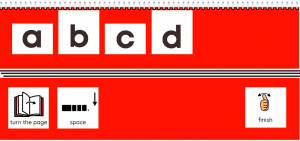
Direct access typical flip chart
Flip charts as a writing tool appealed to me for a lot of reasons. Firstly, because I was working with a range of students with different access needs. Some of them could point, some of them used partner assisted scanning, some of them used eye gaze. Which meant there was a flip chart option for every single student I worked with.
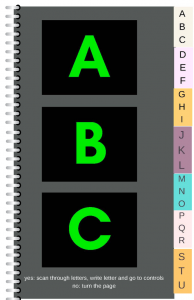
Partner assisted scanning flip chart – 3 letters per page, high contrast
Another reason flip charts appealed to me was because they were cheap! At the time, most assistive technology cost a lot, and it was a long process to get funding for it in my area. So, flip charts enabled students to get on with writing while we waited for the funding to be approved (often over a year).
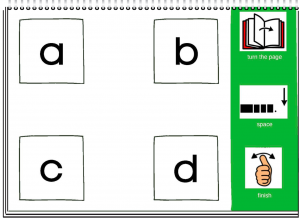
4 letters per page – great for whole hand pointing
The outcome of all that flip chart use, was that I learned that writing flip charts are an amazing writing tool for many emergent writers. Many students made huge progress while using them. And I learned that flip charts often have big advantages over other writing tools for emergent writers.
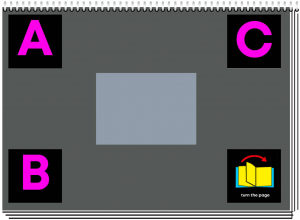
Eye gaze flip chart – high contrast
These days, I work with a lot of different educators in a lot of different schools. I frequently have people tell me that “we haven’t used a flip chart – I thought the keyboard in his iPad would be better” – and I decided it was time to write a blog post about why a flip chart is a great tool for many emergent writers.
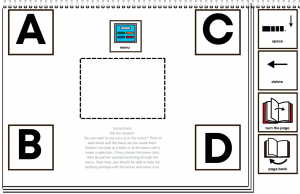
Combination access flip chart – eye gaze for letter selection, partner assisted scanning for menu
Flip Charts come with LOTS of Teaching and Learning Moments
For me, the biggest reason I like to use a flip chart with an emergent writer is all the teachable moments it provides. Please watch the below video with an early emergent writer to check it out!
Many early emergent students need to learn that they are a writer. Having repeated, intentional interactions with an adult around their writing helps them to learn that. The positive feedback, the interactions and the success, all help them to learn they are a writer.
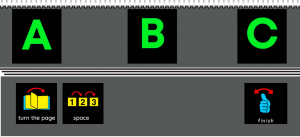
Direct access, high contrast, 3 letters per page
For many students I work with, technology has a lot of established expectations around it. For example, a student might perceive the iPad as a tool for videos, rather than a writing tool. Those expectations might interfere with us having those repeated, intentional interactions. But I usually find we can still have them if I switch to a flip chart instead.
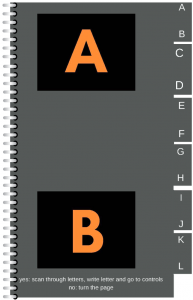
Partner assisted scanning flip chart, 2 letters per page, high contrast
The flip chart also gives us an opportunity to repeatedly name the letters of the alphabet. I have no data that says that this improves alphabet knowledge, but I can’t help thinking that naming the letters again and again must help!
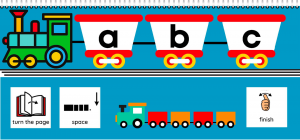
Themed flip chart for a student who loves trains
But, when we are using a QWERTY keyboard on an iPad I definitely don’t sit there and name all 26 letters repeatedly as a student thinks about which letter to use. In fact, some students have already typed a whole heap of letters before I can even say a letter name!
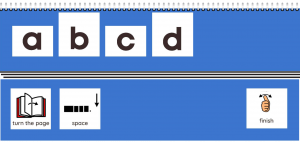
Direct access, typical flip chart
(And before this sounds a little too flip-chart-centric, this doesn’t mean that I want a student to always use a flip chart. There might be times in the day when they write with a keyboard as part of play or other activities – but there are also times in the day I want to have these intentional interactions with them so that emergent writers can learn the functions of print – “print has meaning” and “everything I say, I can write”.)
Another reason I think flip charts rock, is that they give us a chance to celebrate successes as they happen, and to repeatedly attribute meaning.
If a student has just been playing with play dough and has now moved onto writing about it, I keep that in mind as they scribble with letters. So, if they choose the letter P I can say “yay – P for play dough – wow!”. If they choose the letter R I can say “maybe you’re talking about rolling the play dough”. I get so many more of those moments when we write with a flip chart. And those moments help to teach those functions of print. It’s so much easier to learn that print has meaning when we’re talking about the meaning. And of course, that also helps them to learn that everything we say we can write. Again, the speed with which things happen when writing with an electronic keyboard often prevent these interactions from happening.
Check out the video below to see how very cool flip chart writing is! And how many of those teaching and learning moments we get 🙂
And, finally, the original reasons I used a flip chart still apply. They are still cheap – and you can download templates to print and make them from the Centre for Literacy and Disability Studies alternative pencils page or from my Comprehensive Literacy website.
There are also flip charts for so many different access methods, for different vision needs, etc. You can access an ever growing range of flip charts from my website on the Writing by Me page. There are flip charts for students who can point, eye gaze flip charts, high contrast flip charts with accommodations for vision needs and combination access flip charts for students who are using both eye gaze and partner assisted scanning. And customised flip charts as well!
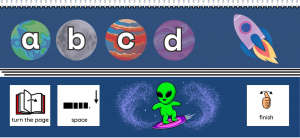
Space themed flip chart
And once any students knows most of the letters, most of the time, we definitely want them to move to a QWERTY keyboard (or another arrangement that enables easier access to all 26 letters).
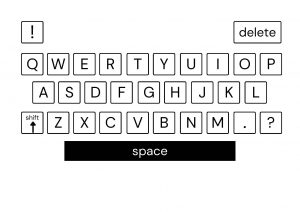
QWERTY keyboard
Happy flip charting!!

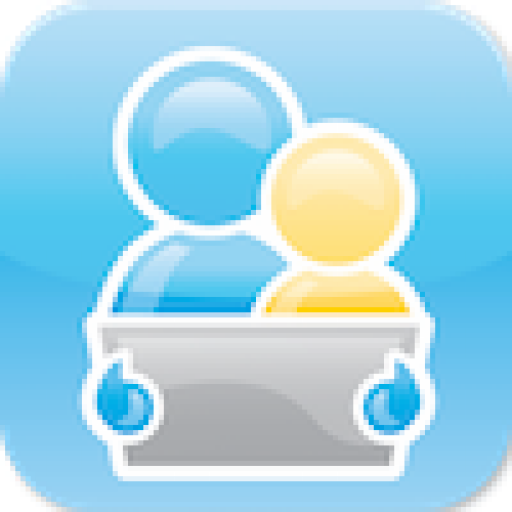
Lisa AntleyL
jane
jennifer
jane